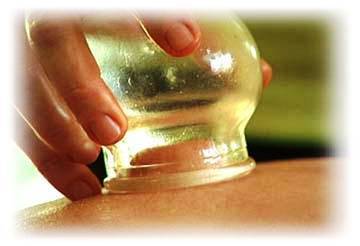What is Cupping

What is cupping
therapy?
Cupping is a method of relieving local congestion by applying
a partial vacuum that is created in a cup(s), either by heat or by suction.
Cupping has been used for thousands of years. Although it is
often associated with Traditional Chinese Medicine, the entire world once knew of this therapy and used
it.
The Ancient Egyptians, Greeks and Chinese used cupping therapy.
The oldest recorded medical textbook, Ebers Papyrus, written in approximately
1550 BCE in Egypt, mentions cupping (Curtis, 2005).
In the UK, the practice of cupping therapy also dates back a long time in one
of their leading medical journals, The Lancet. It was named after this practice as it refers to the surgical
instrument that can scrape the skin to perform a style of cupping.
Conditions Which Can Benefit From Cupping
 Flu Flu
 PMS PMS
 Asthma Asthma
 Stress Stress
 Hip
Pain Hip
Pain
 Muscle
Pain Muscle
Pain
 Joint Pain Joint Pain
 Arthritis Arthritis
 Headaches Headaches
 Neck Pain Neck Pain
 Back Pain Back Pain
 Shoulder Pain Shoulder Pain
 Relaxation
Relaxation
 Muscle
Tightness Muscle
Tightness
 Common Colds Common Colds
What Happens During A Treatment
During a cupping treatment, the practitioner will place a flammable substance (such as herbs or
alcohol) inside a cup, and then ignite that substance.
When the fire goes out, the practitioner places the cup upside-down over certain qi
pathways linked to the condition being treated.
The cup is usually left in place for five to ten minutes, during which time blood
vessels expand and increase circulation.
Cupping is also thought to open up the skin's pores
and promote detoxification.
Scroll down to the bottom of this page for video demonstrations on cupping.
Is cupping safe? Does it
hurt?
While cupping is considered relatively
safe (especially air cupping, which does not include the risk of fire and heat), it can cause some swelling
and bruising on the skin.
As the skin under a cup is drawn up, the blood vessels at the surface of
the skin expand.
This may result in small, circular bruises on the areas where the cups
were applied.
These bruises are usually painless, however, and disappear within a few days of
treatment.
In
addition, there are several instances where cupping should not be performed.
Patients with inflamed skin; cases of high fever or convulsions; and patients who
bleed easily, are not suitable candidates for cupping. Pregnant women should not have cupping on their stomach or
lower back.
If the cups are being moved, they should not cross bony areas, such as the ridges of
the spine or the shoulder blades.
| 
